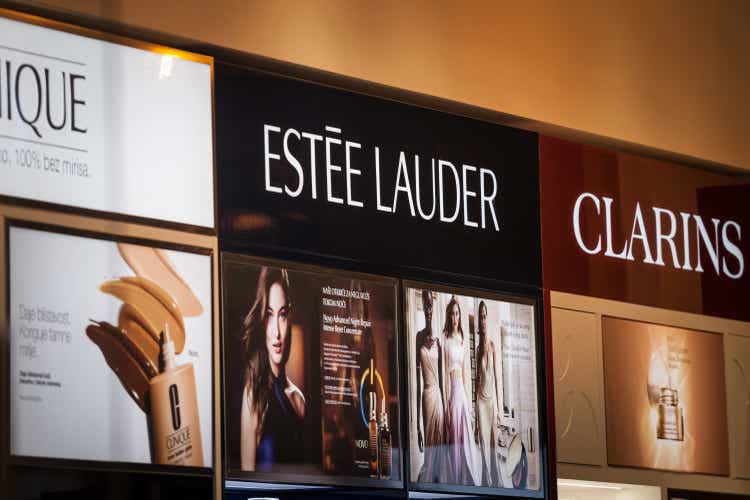BalkansCat
It has been a while since I last had a look at shares of Estée Lauder (NYSE:EL). Back in 2016, I called shares quite expensive despite regained operational momentum. I observed that Estée lauder has been an excellent steward of long-term shareholder value, even as shares of the luxury beauty product maker have been trading stagnant a bit at the time.
A Recap
Back in 2016, Estée was an $11 billion beauty product conglomerate which was active in a range of price categories, having operations across the globe. The company was notably strong in make-up and skin care, competing with the likes of L’Oréal and even higher-end names like LVMH, among others.
The company derived half of sales from old-fashioned department stores, complemented by specialty channels like Ulta Salon (ULTA) as well as online business models of course. The company generated $11 billion in sales and operating margins around 15% of sales as shares traded at $77 late that year.
This was driven by the anticipation of earnings of around $3.25 per share, as a 23-24 times earnings multiple was a bit steep, even at 20-21 times adjusted earnings. This valuation came alongside a modest net debt load of $1.3 billion, with EBITDA trending around $2 billion a year.
Recognizing that the valuations were full, many other luxury names commanded even higher multiples. I hoped to be able to buy shares in the sixties, but shares never saw those levels again, as it was all uphill from that point in time.
A Boom – And Partial Bust
Shares of Estée Lauder tripled to $200 ahead of the pandemic early in 2020 as shares kept rallying and rose to $375 per share by the turn of 2021 into 2022. Ever since, shares corrected partially as well, now trading at $217 per share, still having tripled from levels seen in 2016.
Forwarding to August of this year, Estée Lauder posted a 9% increase in sales to $17.74 billion, almost entirely driven by organic growth which contributed 8% to reported sales growth. Skincare is responsible for nearly $10 billion in sales, complemented by a smaller $4.7 billion make-up business, rapidly growing $2.5 billion fragrance segment and more than $600 million hair care business.
The composition of the sales is key as skincare revenue is responsible for more than 80% of earnings. While fragrance is solidly profitable as well, margins of the make-up activities are dismal, while hair care is a lossmaking operation, leaving potential as well.
Adjusted earnings rose 12% to $7.24 per share, having doubled from 2016, as operating margins have expanded towards 20%, resulting in a $4.2 billion EBITDA number. This measure of profitability is very strong in relation to a $1.4 billion net debt load, leaving ample financial strength.
Despite sales having risen some 60% since 2016 and earnings per share essentially doubling, valuation multiples have expanded, even after the dismal share price performance so far this year. After all, shares trade at exactly 30 times earnings, while the balance sheet is largely unleveraged. The company has grown to a large valuation, currently being awarded a $79 billion equity valuation.
For the fiscal year 2023, the company guided for 3-5% sales growth, yet this number included a three-point headwind from a strong dollar, as well as two-point headwind from license deals ending and the exposure to Russia. Adjusted earnings are set to rise in a modest fashion to $7.39-$7.54 per share.
Reflective of the strong outlook, the company hiked the quarterly dividend by ten percent to $0.66 per share, for a yield just in excess of a percent. After a softer first quarter, for which the company warned, the company cut the full year guidance in a big way. Full-year sales are now seen down by around 7% with adjusted earnings now seen between just $5.25 and $5.40 per share, as the extent of the earnings shortfall is huge, driven by a stronger dollar. Fortunately, the dollar has recently lost some ground, albeit that Covid-19 restriction in China remain in place.
A Big Deal
With some share buybacks executed upon during the first quarter, Estée Lauder has built up a net debt load of $2.5 billion again, supporting an $80 billion enterprise valuation here at nearly 5 times sales and 30 times earnings based on fiscal 2022 earnings, albeit that earnings are set to fall this year.
During these difficult circumstances, the company reached a deal to acquire Tom Ford in a $2.8 billion deal in November, albeit that $300 million of the price tag includes deferred payments due in July 2025. Given the size, this is a bolt-on deal, valued at 3-4% of Estée’s own valuation here. The deal is set to be dilutive by $0.05-$0.15 per share, or up to $50 million in the worst case.
A pro forma net debt load of around $5 billion is perfectly manageable here, but the degree of the earnings shortfall seen so far this year, and relatively expensive deal, does raise some questions as shares of Estée have seen a dreadful performance so far this year.
Weighing all this together, I remain very cautious as I am in no need to get involved with the shares here, despite an excellent long-term value creating track record.


Be the first to comment